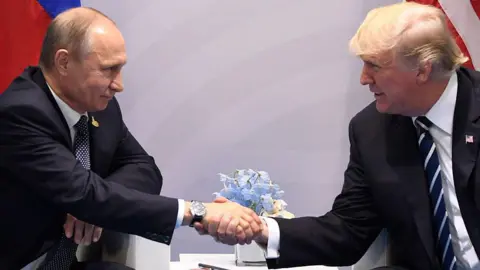The upcoming summit in Alaska, featuring US President Donald Trump and Russian President Vladimir Putin, has generated considerable anticipation, particularly due to the stark differences in their objectives. This meeting, scheduled for Friday, represents a critical juncture in international relations as both leaders arrive with distinct agendas. While Putin has consistently articulated his ambition to expand Russian influence through territorial gains in Ukraine, Trump is positioning himself as a prospective global peacemaker with hopes of resolving the ongoing conflict.
Putin’s strategy focuses on consolidating Russian territorial gains in the Donetsk, Luhansk, Zaporizhzhia, and Kherson regions of Ukraine. His objectives center not only on acquiring official recognition of these territories as Russian but also on asserting that Western attempts to isolate him have been unsuccessful. The very fact that this high-profile summit is occurring demonstrates a significant shift in the geopolitical landscape, as Putin seeks to portray Russia as a resilient power capable of engaging with the West on equal footing.
One of Putin’s critical aims is to obtain formal acknowledgment from the United States of Russia’s status as a legitimate actor in global politics. This includes a symbolic victory of conducting talks in a place like Alaska, which is within close geographic proximity to Russia, allowing Putin to bypass crossing through “hostile” nations. This aspect of the summit not only underscores his security concerns but serves to illustrate historical ties, as Putin’s narratives often invoke the 19th-century sale of Alaska to the United States.
At the same time, the Russian economy is under significant stress due to an escalating budget deficit coupled with declining revenues from oil and gas exports. This economic pressure may influence Putin’s decision-making during the talks. Should he perceive a need to compromise, it may alter Russia’s assertiveness on the battlefield and influence its commitment to achieving a full military victory in Ukraine.
Conversely, Trump’s motivations appear to be more complex. Throughout his presidential campaign, he asserted that establishing peace in Ukraine would be straightforward, potentially achievable in mere days. However, since taking office, his approach has fluctuated between criticism of Ukrainian resolve and tempered engagement with Putin. There seems to be a growing intention on Trump’s part to project himself as a decisive figure in international diplomacy, potentially even as a peacemaker. Yet his history is marked by vacillation and rhetorical inconsistencies regarding his commitment to Ukraine and relations with Russia.
In the lead-up to the summit, Trump has set artificially low expectations regarding the outcome, framing the meeting as an opportunity to “feel-out” Putin. This indicates a recognition of the challenges inherent in achieving a diplomatic breakthrough, especially with one party to the conflict absent from the discussions. Nevertheless, Trump’s desire for a resolution is underscored by his aspirations for historical recognition, perhaps even a Nobel Peace Prize, as he positions himself against a backdrop of failed international negotiations.
The negotiation dynamic will also be affected by recent comments and expectations set forth by European leaders, who hope Trump will not broker any agreement that compromises Ukrainian territorial integrity. Both Trump and Putin will be navigating a landscape fraught with uncertainty, as the stakes remain high for both leaders despite their opposing priorities. Ultimately, while Putin’s ambitions center on securing territorial claims and international legitimacy, Trump seeks the framing of a successful diplomacy initiative, even if it means making concessions that may affect Ukraine’s sovereignty. The summit in Anchorage stands as a critical point for both leaders, revealing much about their respective strategies, and the potentially far-reaching implications for geopolitical stability.












